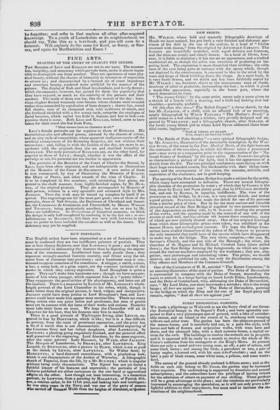NEW PRINTS.
Wit.xix, whose bold and masterly lithographic drawings of Heads we have noticed, has put forth a very finished and elaborate spe- cimen of his skill in the use of the crayon, in a head of " Christ crowned with thorns," from the original by ANNIBALE CARAC CI. The features are beautifully modelled, with equal delicacy and firmness, and the tints are evenly and clearly drawn. As a head of Christ, how. ever, it is liable to objection ; it has too set an appearance, and a studied academical air, as though the artist was conscious of producing an im- posing head. The expression is more theatrical than sublime ; the cairn turn of the eyes being quite at variance with the agony which, though not depicted in the countenance, is conveyed in idea to the mind by the tears and drops of blood trickling down the visage. As a mere head, it is very finely drawn, and we doubt not has been faithfully copied by Mr. WILKIN : we, however, object to the monotonous mass of shade, destitute of relief or gradation, surrounding the face ; to which it gives a mask-like appearance, especially in the lower part, where the beard determines its form.
" The young Critic," by the same artist, seems only a name given to a sketch of a female with a drawing, and a little boy looking over her shoulder,—portraits, probably.
Of this class also are—" The Ballad Singer," a clever sketch, by the late Mr. JACKSON, of a child, with an affected look of no meaning, neatly lithographed by WELD TAYLOR " The Mother's Jewel," a child seated on a bed admiring a trinket, very prettily designed and en- graved by WOOLNOTH ; and a lithographic sketch, after GIRARD, of the lovely young Greek girl to whom Lord Byron addressed those beau- tiful verses, beginning- " Maid of Athens, ere we part, Give, oh give me back my heart."
" The Battle of Palm Sunday "—a very spirited lithographic design, by Mr. ANDREWS, illustrative of the memorable description by Sir WAL- TER SCOTT, of the scene in the Fair Maid of Perth, of the fight between the remnants of the two clans, in which the Glover takes a prominent part—may serve as a companion print to the representation of the " Na- tional Games of Scotland," by the same artist. Mr. ANDREWS has given so characteristic a picture of the fight, that it has the appearance of a sketch from the life. The two principal combatants seem laying on with their huge two-handed swords; like blacksmiths with their sledgeham- mers; and the arrangement of the scene, the costume, attitude, and expression of the characters, are in good keeping.
The opening of the New London Bridge has made a subject for the artist, which many have attempted to delineate. There are several lithogra- phic sketches of the procession by water ; of which that by COOPER is the best, those by ESSEX and Nasu pretty good, that by O'Cossrou decidedly bad, and one by HAVELL, in aquatint, indifferent. The view of the procession on the bridge, by ALeom, is a very clever sketch, and makes a good picture. STANFIELD has made the sketch for one of his pictures from a similar point of view. But by far the most curious and valuable pictorial record of the New Bridge is supplied by two panoramic views of the Approaches on either side, by G. SCHARF, showing the progress of the works, and the opening made by the removal of one side of the streets at each end, and the curious old houses there remaining, many of which are now entirely cleared away. One of the original drawings from which these lithographic prints were taken, was exhibited -at So- merset House, and excited great interest. We hope the Bridge Com- mittee have availed themselves of the talent of Mr. SCHARF to preserVe the only memorial they could have of the streets which have disappeared to make way for the bridge. The two views comprise,—the one, St. Saviour's Church, and the east side of the Borough ; the other, the churches of St. Magnus and St. Michael, Crooked Lane (since pulled down); the New Bridge forming the foregrounds, on which are repre- sented the various machines employed by the workmen; they are, alto- gether, very picturesque and interesting views. The prints, we should observe, are not published for sale, out only for distribution among the City officers and Members of the Common Council.
One of the Caricatures of H. B., entitled "The Retort Courteous," is an amusing illustration of the state of parties. The Duke of Devonshire is represented ire company with the Duke of Sussex, descending the stairs to embark in a barge having on board Lords Eldon, Londonderry, and the Duke of Cumberland, who, addressing the Duke of Devonshire, says, " My Lord Duke, you must have made a mistake; this is the wrong barge ; all here are against you." The Duke of Devonshire, pointing to the bridge on which the King and the rest of the Royal party still remain, replies, " And all there are against you."


























 Previous page
Previous page